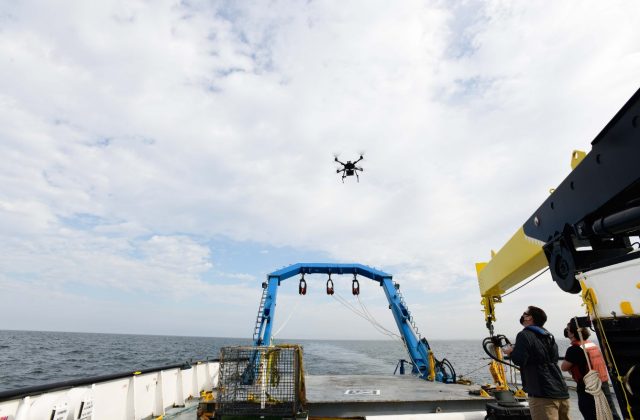US Navy researchers recently took an idea to use drones to test and evaluate ships’ new laser weapons a step further by successfully launching and landing one from a moving ship.
From a few miles off the Port Hueneme coast, NSWC PHD Research and Technology Applications Manager Alan Jaeger and Cybersecurity Researcher, Ian Wilson, made a quadcopter take off, hover and fly alongside the side of the ship, and then land from a stationary and moving ship. The quadcopter was operating with San Diego, Calif.-based Planck Aerosystems Inc.’s autonomous navigation software that the pair had certified on earlier this year. The software is specially designed so Autonomous Aerial Vehicles (UAV) correctly maneuver and operate independently from ships and other moving platforms that heave and roll amid high winds and tight spaces so a pilot is not needed.
The drone will eventually carry a special piece of electronics that will measure key performance parameters of the navy’s high-power and newer Laser Weapon System Demonstrator, currently installed on USS Portland (LPD 27). The ship will use the drone as an instrumented target and the electronics will collect the data.
Before that can happen, Jaeger and Wilson had to test the drone for how well it could fly, hover, keep pace with a moving and still ship, and land all on its own; all while weighing similar to the real electronics, so sailors don’t have to manually operate it while also performing their regular ship duties.
“We’re here to find some bugs so we can determine if the drone and the software are ready for USS Portland,” Jaeger said. The pair conducted the test during the annual Coastal Trident (CT) Port and adjunct Maritime Security Program/Advanced Naval Technology Exercise (ANTX) in September. Planck Aerosystems participated in the 2019 event.
The pair prepared for two days prior to the test because the 55-pound drone that measured about 50 inches from mid-propeller to mid-propeller, was larger and heavier than the drones they previously tested. They fitted quadcopter with an ID tag and a “payload” the same as what will eventually be used in the test with USS Portland on the nearby Point Mugu Sea Test Range in upcoming months.
Jaeger and Wilson are testing the concept on behalf of the Test Resource Management Center (TRMC), which came up with the idea and is the project’s funding source.
Through several tests, the drone rose straight up from the ship, then flew in a straight line over the water to hover about 75 meters off the port side. In the first test, the ship was stationary and the UAV hovered over the water for several minutes before smoothly returning to the same spot. In the next tests, the drone performed those maneuvers while the ship was moving at first 5 and then 10 knots, and the UAV flew steadily forward in a straight line while keeping pace with the ship. When it returned to the ship, it hovered over a target that resembled three QR codes laid on the ship’s floor.
During the tests, the UAV “met objectives,” but needs some refining,” Jaeger added. The drone material, for instance, needs to be waterproofed or else it will corrode in ships’ maritime environment.
The next step for Wilson and Jaeger will be to work with PHD’s directed energy team to develop a test plan and objectives for an actual test with the Portland on the Point Mugu test range. Wilson will also need to get certified by the Federal Aviation Administration to operate a drone in the national airspace.



























